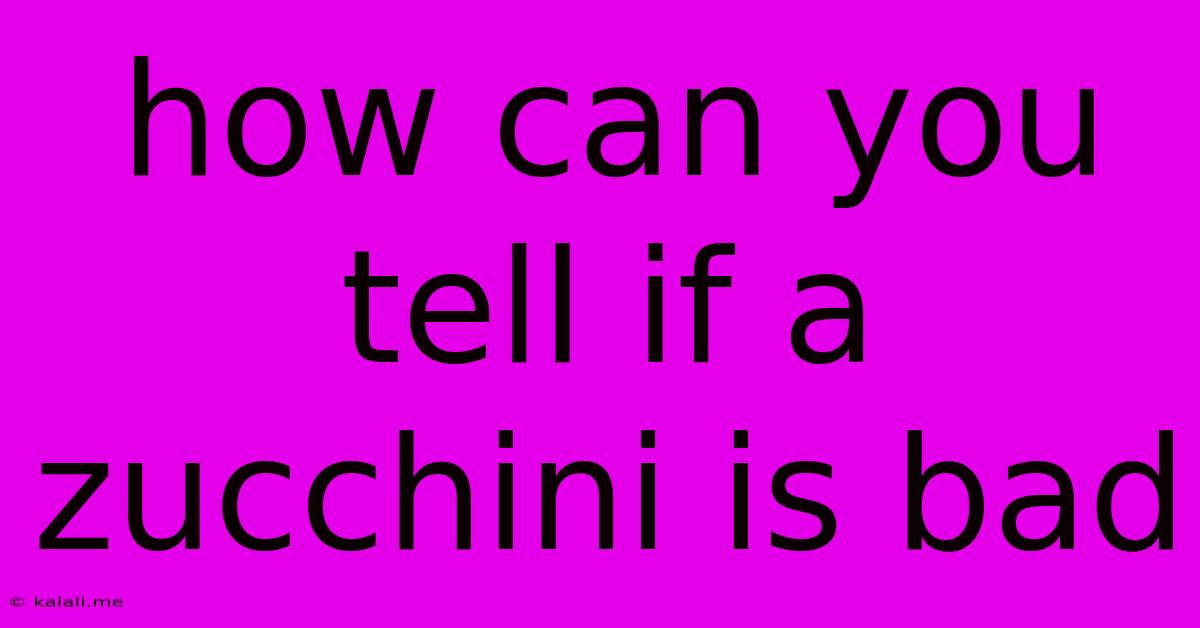How Can You Tell If A Zucchini Is Bad
Kalali
Jun 05, 2025 · 3 min read

Table of Contents
How to Tell if Your Zucchini is Bad: A Guide to Spotting Spoiled Squash
Choosing the perfect zucchini can be the difference between a delicious summer meal and a disappointing culinary experience. Knowing how to identify a bad zucchini before you even bring it home can save you time, money, and frustration. This guide will walk you through the key signs of spoiled zucchini, helping you select only the freshest and tastiest squash for your recipes.
What to Look for in a Good Zucchini:
Before we delve into the signs of spoilage, let's establish what a good zucchini looks like. A fresh zucchini should be firm to the touch, with smooth, unblemished skin. The color should be a vibrant deep green, consistent throughout. Avoid zucchini with soft spots, bruises, or blemishes. A slightly heavy zucchini for its size often indicates good hydration and freshness. The stem should be firm and attached; a detached or wilted stem is often a sign that the zucchini is starting to go bad.
Key Indicators of Bad Zucchini:
Several telltale signs can indicate that your zucchini has gone bad. Pay close attention to these points:
1. Soft Spots and Mushiness:
This is perhaps the most common sign of zucchini spoilage. If you press gently on the zucchini and feel soft, mushy areas, it's time to discard it. These soft spots are indicative of bacterial or fungal growth, rendering the zucchini unsafe for consumption.
2. Changes in Color and Appearance:
While a deep green is ideal, a significant discoloration or yellowing is a warning sign. Brown spots or patches on the skin or flesh are also indicators of decay. These changes suggest deterioration and potential spoilage. Similarly, wrinkles or shrivelling indicates that the zucchini is losing moisture and becoming less palatable.
3. Slimy Texture:
A slimy or sticky surface is a strong indicator of bacterial growth and decomposition. This is a clear sign that the zucchini has passed its prime and should be immediately discarded. Do not attempt to salvage it by cutting off the affected areas; the bacteria likely has already spread throughout.
4. Unpleasant Odor:**
A fresh zucchini has a mild, slightly earthy aroma. If your zucchini emits a foul, sour, or musty smell, it's definitely spoiled. This odor is a result of microbial activity and signifies significant deterioration.
5. Mold Growth:
The presence of any mold, no matter how small, is a definite sign that the zucchini is no longer safe to eat. Mold can produce toxins that are harmful to your health.
How to Store Zucchini to Extend its Shelf Life:
Proper storage significantly impacts the shelf life of your zucchini. Store your zucchini in a cool, dry place, ideally in the refrigerator. Avoid storing it in airtight containers, as this can promote moisture build-up and spoilage. Proper storage can help your zucchini stay fresh for up to a week.
Conclusion:
Identifying a bad zucchini is crucial for ensuring food safety and preventing waste. By paying attention to the key indicators discussed above – texture, color, odor, and the presence of mold – you can easily determine the freshness of your zucchini and enjoy delicious, healthy meals. Remember, when in doubt, throw it out!
Latest Posts
Latest Posts
-
App Not Installed As App Isnt Compatible
Jun 06, 2025
-
Can I Use Iodized Salt For Brine
Jun 06, 2025
-
How To Play Twinkle Twinkle Little Star Piano
Jun 06, 2025
-
What Is A Rectangle In 3d Called
Jun 06, 2025
-
See Icloud Storage Files Sorted By Size
Jun 06, 2025
Related Post
Thank you for visiting our website which covers about How Can You Tell If A Zucchini Is Bad . We hope the information provided has been useful to you. Feel free to contact us if you have any questions or need further assistance. See you next time and don't miss to bookmark.